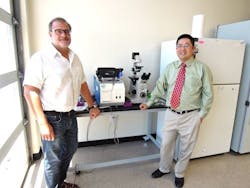Raman spectroscopy-based biosensor has utility in medical diagnostics, food safety
Lawrence Berkeley National Laboratory (Berkeley Lab; Berkeley, CA) and spinoff company Optokey (Hayward, CA) have developed a miniaturized biosensor based on Raman spectroscopy that can quickly and accurately detect or diagnose substances at a molecular level.
Related: Ultrabright protein nanoprobes promising for bioimaging
The biosensor technology is based on surface-enhanced Raman spectroscopy (SERS), a technique for molecular fingerprinting. While SERS is a highly sensitive analytical tool, the results are not easily reproducible. Optokey president and co-founder Fanqing Frank Chen and colleagues developed a solution to this problem using what they called "nanoplasmonic resonators," which measures the interaction of photons with an activated surface using nanostructures to do biosensing. The method produces measurements much more reliably. Chen says that Optokey is able to mass-produce the nanoplasmonic resonator on a wafer scale.
The miniaturized sensors use a microfluidic control system for lab-on-a-chip automated liquid sampling. The company is taking a page from the semiconductor industry in making its chip. "We're leveraging knowledge acquired from high-tech semiconductor manufacturing methods to get the cost, the volume, and the accuracy in the chip," says Optokey VP of manufacturing Robert Chebi, a veteran of the microelectronic industry who previously worked at Lam Research and Applied Materials. "We're also leveraging all the knowledge in lasers and optics for this specific Raman-based method."
Chebi calls Optokey's product a "biochemical nose," or an advanced nanophotonic automated system, with sensitivity to the level of a single molecule. "Today's detection and diagnosis methods are far from perfect—detection limits are in PPM (parts per million) and PPB (parts per billion)," he says. "Also, our system can provide information in minutes, or even on a continuous basis, vs. other methods where it could take hours or even days, if samples have to be sent to another lab."
The potential applications, he says, are vast, including food safety, environmental monitoring (of both liquids and gases), medical diagnosis, and chemical analysis. Optokey's customers include a major European company interested in food safety, a Chinese petrochemical company interested in detecting impurities in its products, and a German company interested in point-of-care diagnosis.
The next market Chen is targeting is the smart home, where a nanophotonic sensor could be built to scan for pollutants not just in food but also in air and water.
For more information, please visit www.optokey.com.
Follow us on Twitter, 'like' us on Facebook, connect with us on Google+, and join our group on LinkedIn

